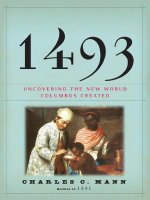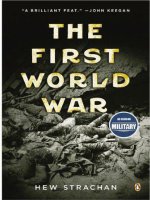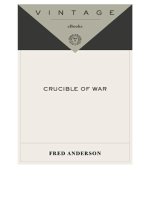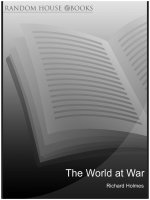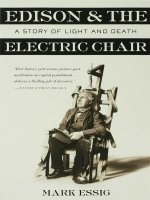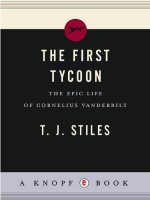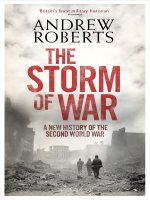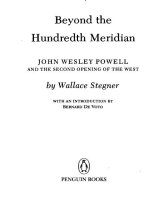James e campbell the ghost mountain boys (v5 0)
Bạn đang xem bản rút gọn của tài liệu. Xem và tải ngay bản đầy đủ của tài liệu tại đây (1.56 MB, 274 trang )
Contents
TITLE PAGE
DEDICATION
A GUIDE TO THE BOOK’S MAJOR CHARACTERS
AUTHOR’S NOTE
INTRODUCTION
MAPS
PROLOGUE
BOOK ONE
Chapter 1
ESCAPE TO THE SOUTH
Chapter 2
A TRAIN HEADING WEST
Chapter 3
ARRIVAL DOWN UNDER
Chapter 4
SONS OF HEAVEN
Chapter 5
CANNIBAL ISLAND
BOOK TWO
Chapter 6
FORLORN HOPE
Chapter 7
THE BLOODY TRACK
Chapter 8
MARCHING INTO THE CLOUDS
Chapter 9
Chapter 10
ONE GREEN HELL
TO SWALLOW ONE’S TEARS
(NAMIDA O NOMU)
Chapter 11
FEVER RIDGE
BOOK THREE
Chapter 12
THE KILL ZONE
Chapter 13
A POOR MAN’S WAR
Chapter 14
IF THEY DON’T STINK, STICK ’EM
Chapter 15
THE BUTCHER’S BILL
Chapter 16
BREAKING THE STALEMATE
Chapter 17
CAGED BIRDS
EPILOGUE
NOTES
BIBLIOGRAPHY
ACKNOWLEDGMENTS
COPYRIGHT
To Elizabeth, for her patience and grace, and to our
daughters Aidan, Rachel, and Willa
And to the Red Arrow men of New Guinea and their families
A Guide to the Book’s Major Characters
U.S. COMMAND STRUCTURE
General Douglas MacArthur: Commander in Chief Southwest Pacific Area
Major General Richard Sutherland: MacArthur’s Chief of Staff
Brigadier General Charles Willoughby: MacArthur’s Head of Intelligence (G-2)
Major General George Kenney: Commander of Allied Air Forces
Brigadier General Hugh Casey: MacArthur’s Engineer Officer
Major General Edwin Forrest Harding: Commanding General 32nd U.S. Infantry Division from
February 1942–December 1, 1942
Lieutenant General Robert Eichelberger: Commander I Corps. Assumed command of all U.S.
forces east of the Girua River in early December 1942
AUSTRALIAN COMMAND STRUCTURE
General Sir Thomas Blamey: Commander Allied Land Forces SWPA
Major General Basil Morris: General Officer Commanding New Guinea Force
Lieutenant General Sydney Rowell: Replaced Morris as General Officer Commanding New
Guinea Force on August 10, 1942
Lieutenant General Edmund Herring: Replaced General Rowell in late October 1942
Major General Arthur “Tubby” Allen: General Officer Commanding 7th Australian Division
Major General George Vasey: Replaced Tubby Allen as Commanding Officer of the 7th Australian
Division on October 27, 1942
32ND U.S. INFANTRY DIVISION
Colonel Lawrence Quinn: Commander 126th Infantry Regiment until November 5
Colonel John Mott: Temporary Commander Urbana Force
Colonel John Grose: Assumed command of Urbana Force on December 4, 1942. Three days later,
turned over command of Urbana Force to Colonel Clarence Tomlinson. Then took over command of
the 127th Infantry Regiment. Resumed command of Urbana Force on December 20, 1942
Lieutenant Colonel Clarence Tomlinson: Assumed command of the 126th Infantry after Quinn.
Took over command of Urbana Force on December 7, 1942. Relieved of duties on December 20 due
to exhaustion, but remained Commander of the 126th Infantry
Lieutenant Colonel Herbert Smith: Commander 2nd Battalion 128th Infantry Regiment
Major Herbert “Stutterin’” Smith: Commander 2nd Battalion 126th Infantry Regiment
Captain William “Jim” Boice: Regimental Intelligence Officer (G-2), and leader of the Pathfinder
Patrol
URBANA FRONT
Lieutenant Robert Odell: Platoon leader Company F 2nd Battalion 126th Infantry Regiment. Took
command of the company in early December 1942
Lieutenant James Hunt: Head of communications section attached to Company E, then F, and
eventually Battalion Headquarters 126th Infantry Regiment
Sergeant Herman Bottcher: Platoon commander Company H 2nd Battalion 126th Infantry Regiment.
Attached to Company G
COMPANY G 2ND BATTALION 126TH INFANTRY REGIMENT
Lieutenant Cladie “Gus” Bailey: Commanding Officer
Sergeant Don Stout
Sergeant Don Ritter
Corporal Stanley Jastrzembski
Corporal Carl Stenberg
Privates First Class Russell Buys, Samuel DiMaggio, Chester Sokoloski
COMPANY E 2ND BATTALION 126TH INFANTRY REGIMENT
Captain Melvin Schultz: Commanding Officer
1st Sergeant Paul Lutjens
Sergeant John Fredericks
Private First Class Arthur Edson
SANANANDA FRONT
Captain Alfred Medendorp: Leader of the Wairopi Patrol, Commanding Officer of Cannon and K
Companies
Captain Roger Keast: Second-in-command Wairopi Patrol, and Commanding Officer Antitank
Company
Captain John Shirley: Commanding Officer Company I 3rd Battalion 126th Infantry Regiment
Captain Meredith Huggins: Operations Officer (S-3) 3rd Battalion 126th Infantry Regiment
Lieutenant Peter Dal Ponte: Commanding Officer Service Company 3rd Battalion 126th Infantry
Regiment
Lieutenant Hershel Horton: Platoon Commander Company I 3rd Battalion 126th Infantry Regiment
Father Stephen Dzienis: Chaplain 126th Infantry Regiment
Lieutenant Lester Segal: Physician assigned to Wairopi Patrol
Major Simon Warmenhoven: Regimental Surgeon, 126th Infantry Regiment. Served on both
Sanananda and Buna Fronts
Author’s Note
IN 1884 THE ISLAND of New Guinea was partitioned by three Western powers. The Dutch claimed the
western half (it was handed over to Indonesia in November 1969 and is now called the province of
Papua, formerly Irian Jaya), and the Germans and British divided the eastern half. The southern
section of the eastern half became a British protectorate (British New Guinea Territory) and passed
to Australia in 1906 as the Territory of Papua. The northern section formed part of German New
Guinea, or Kaiser-Wilhelmsland. During World War I, it was occupied by Australian forces and in
1920 was mandated to Australia by the League of Nations. It became known as the Territory of New
Guinea.
Although the Battles of Buna and Sanananda took place in the Territory of Papua, because people
generally refer to the island as New Guinea, I do, too, in order to avoid potentially confusing
distinctions.
Introduction
NEW GUINEA WAS an unlikely place in which to wage a war for world domination. It was an
inhospitable, only cursorily mapped, disease-ridden land. Almost no one—not the elite units of the
Japanese forces that invaded New Guinea’s north coast in July 1942, not the Australian Imperial
Forces or its militia, and maybe least of all the U.S. Army’s 32nd “Red Arrow” Division—was
prepared for what military historian Eric Bergerud calls “some of the harshest terrain ever faced by
land armies in the history of the war.”
In New Guinea, exhaustion and disease pushed armies to the breaking point. Losses to malaria
alone were crippling. Sixty-seven percent of the 14,500 American troops involved in the battles for
Buna and Sanananda contracted the disease. On the Sanananda Front, casualties due to malaria were
over 80 percent.
The suffering was enormous on all sides. For the Americans, it could have been alleviated, at least
initially, by better planning. But eventually the topography and climate would still have exacted a
terrible toll.
By the time the Red Arrow men arrived in New Guinea in September 1942, U.S. Marine troops
were already fighting a brutal, well-documented land battle at Guadalcanal in the Solomon Islands.
The marines had a superbly oiled publicity machine that kept them in the spotlight. The 32nd
Division’s soldiers fighting in New Guinea felt forgotten. The American public, in particular,
suffered from the misperception that except for Guadalcanal, the South Pacific was a naval war with
a few insignificant ground operations thrown in for good measure. By October 1944, they knew that
General Douglas MacArthur, who had fled the Philippines, had returned two and a half years later,
keeping his promise. But they had little idea of what went on in the interim, which is to say that they
had scant knowledge of the land war in New Guinea. Americans’ lack of interest revealed a
geographical ignorance. The European front—and the exception of Guadalcanal—they could
comprehend. The vast blue Pacific with its obscure island nations remained a mystery.
Yet the fighting on the island of New Guinea—especially the early confrontations at Buna and
Sanananda—was every bit as fierce as that at Guadalcanal. General Robert Eichelberger, who would
assume command of the 32nd, wrote that in New Guinea, “Everything favored the enemy.”
Casualties at Buna, in fact, were considerably higher than at Guadalcanal. On Guadalcanal 1,100
troops were killed and 4,350 wounded. The cost of New Guinea’s combined Buna-Sanananda-Gona
campaign was 3,300 killed and 5,500 wounded. As William Manchester points out in his book
American Caesar, “If the difference in the size of attacking forces is taken into account, the loss of
life on Papua (New Guinea) had been three times as great as Guadalcanal’s.”
On New Guinea, as at Guadalcanal, topography determined everything. Tanks and artillery, which
won the day in Europe, were rendered useless. In the matted jungles, men were forced to fight battles
at point-blank range. Soldiers used anything that worked—grenades, fixed bayonets, and, sometimes,
their hands. Eric Bergerud described the struggle as “a knife fight out of the Stone Age.” George
Johnston, an Australian war correspondent, called it one of the “most merciless and most primeval
battles.”
As fierce as the fighting was, the terrain and climate were just as dangerous. General Hugh Casey,
MacArthur’s chief engineer, called New Guinea the “ultimate nightmare country.” Support units, he
said, would face challenges “without precedent in American military history.” Before his first
inspection of the island, he assumed that nothing could compare with Bataan and Samar. But New
Guinea was in a class of its own. War, Casey told MacArthur, would be almost impossible to wage
on the island. His warnings proved prescient.
For the troops of the 32nd Division, New Guinea became “the ultimate nightmare country” indeed.
Lenord Sill would later say, “All who were alive, were so near death…. Our briefing, before we
began near Port Moresby, did not prepare us for what we were about to encounter. In the beginning,
we were all young, healthy GIs, eager to conquer the world…. In a matter of weeks, long before we
met the enemy force, all of us had been transformed into ghosts of our former selves.”
Bob Hartman of Grand Rapids, Michigan, minces no words. “If I owned New Guinea and I owned
hell, I would live in hell and rent out New Guinea.” The first time Carl Smestad saw the Sanananda
battlefront he was convinced that it would be his graveyard. “God help us,” he thought. “We’re never
going to get out of here alive.”
One would think that the 32nd must have been a division of elite fighters, or that it contained units
of crack troops. Nothing could have been further from the truth. Although Field Service regulations
specified “all troops must be thoroughly acclimated before initiating operations,” the men of the 32nd
were not ready for the jungle. When it came time to send the division to New Guinea, a commanding
general judged it soft and just barely fit for combat.
New to jungle warfare, the division lacked even the basics for survival, prompting one military
historian to label the soldiers of the 32nd the “guinea pigs” of the South Pacific. Men were not issued
any of the specialized clothing that later became de rigueur for the war in the South Pacific. For
camouflage, their combat fatigues were hastily dyed before they left Australia. In the rain and extreme
humidity, the dye ran and clogged the cloth, causing men to develop horrible skin ulcers. Soldiers
were forced to wade through vines, creepers, brush, dense stands of razor-sharp kunai grass, and
elephant grass as high as a basketball rim without the aid of machetes. They did not even have insect
repellent—astonishing when one considers that they were fighting in a bug-ridden place. They were
not equipped with waterproof containers either. Matches were often unusable. Quinine and vitamin
pills, salt and chlorination tablets got wet and crumbled in their pants pockets. Never, perhaps, have
American troops been more poorly equipped. Yet, in New Guinea, the 32nd Division was asked to
do the extraordinary.
PROLOGUE
Dearest Lover:
Is it ever grand out—you know, honey, you’ve read in stories about the tropical evenings, a
warm, sultry night with a slight breeze…and a moon peaking thru the clouds. Well, that’s the
way it was to-night. I stood there for a long time, watching and most of all wishing to have you
standing along side of me, and that we could really take advantage of the “Romantic
Atmosphere”…the stillness of the night—Just two things missing—First and most of all, My
Mandy, and then some sweet, faint dance music. Well, we’ll just have to postpone it for the
present…until another night. Give Muriel and Ann my love—I think about you all so often. What
a great day it will be when we can be together again.
Goodbye Sweetheart—All my heart’s love always—Yours forever, Sam
Thursday Nite 6:00 PM.
July 30, 1942
My Sweetheart:
And how’s my Mandy this evening? Let me see, right now it is three oclock in the morning in
Grand Rapids, so you should be sound asleep—wish I could tip toe in on you right at this
moment honey, and take a peep in at you, I’d carefully put a kiss on your lips, your cheeks, your
eyes, and your hair, and then rest my cheek against yours for awhile without awakening you, then
take a good long look at you again and tip toe out.
Yours Forever, Sam
Wednesday Nite 7:50 PM.
Sept. 9, 1942
To “My One and Only:”
I’ll try my best to get my thoughts on paper, but it’s not like being with you darling, sitting
across from you, watching the smile on your face, the touch of your legs under the table…I miss
you love, oh God! How I miss you sometimes…All these things I’ve wanted to tell you, should
have told you before I left…I hope you don’t think I’m sacriligeous but if I were offered my
choice between heaven and you, I’d choose you…I’m going to say goodbye now…
Always your man, Sam
Later that night: Hello darling, here I am again. I hope the censors will let that letter go thru
alright. I started out to write this letter, but wrote that one instead. I have hopes they [the
censors] won’t open the previous letter, certainly no military secrets in there unless it’s a
military secret…that I’m so very, very much in love with you—I’m sure tho that the japs don’t
care about that.
Wed. Nite 8:00 PM.
Somewhere in New Guinea
October 14, 1942
Dearest Lover:
Oct. 14—this is the eve of two years in the army—Two years ago tomorrow we were
inducted…Have been under the “weather” a little of late. Been having a little dysentery…There
are an enormous amount of flies here…I suppose you wonder all about New Guinea…There are
a lot of natives here. Quite a bit of sickness and disease amongst the natives…They have a lot of
skin diseases and eye infections. Lot of the small children walk about with “pot” bellies due to
malnutrition. Pretty near all have rickets—some have large spleens because of malaria. The men
folks wear a cloth about the hips…The women folks wear a tropical grass skirt…The other day I
saw a woman nursing a baby on one breast and a small pig on the other—the natives are very
much tattooed. They make wonderful boatsmen…Night before last crossed a fast streaming river
and two of these natives handled a small boat and took us right straight across like nothing…The
women seem to do much of the work—will see a native carrying a spear coming down a path
and behind him comes his wife all loaded down with fruit, coconuts, wood, etc. on her back and
head, and perhaps a baby sitting on top of that holding on to her hair…
What I’m really looking forward to is the day I step on U.S. soil—what a day that will be…
Goodnight, My Mandy, Lovingly Yours, Sam
Monday Nite
New Guinea
Nov. 2, 1942
Dear Muriel:
And how’s that big daughter of mine getting along—I’ve been wondering about you so much
now that you are going to school…Mommie tells me you are a big girl now. How nice you play
with Ann. Do you like your baby brother?…I sure miss you Muriel, remember how you and I
used to play at night in the house before you went to bed, that was loads of fun, wasn’t it? Am
thinking lots about you.
Love, Your Dad
Late November 1942, Buna Coast, New Guinea:
BEFORE SETTING OUT, they smeared their faces with green paint. Loaded down with hand grenades, .30
and .45 caliber ammunition, and two days’ rations, the Americans struggled through heavy jungle and
dug in just in front of a battalion of Australians. A second American detachment had its sights set on a
spot farther north along the trail. Navigating through hip-deep swamps, the soldiers clashed with a
Japanese patrol, lost their bearings, and ended up well short of their destination. Having realized that
the main advance was falling apart, another company left the banana plantation and pushed forward in
a northwesterly direction through nipa and sago palm. Two hundred yards out it was stopped in its
tracks by heavy Japanese cross fire. Ordered to dig in, the men worked fast. They had just settled into
their trenches when the Japanese attacked. Hundreds of enemy troops bore down on them. They
rushed forward like wild Indians, shouting “Banzai!”, crashing through the jungle, their bayonets
drawn. The Americans froze. The Japanese soldiers were almost upon them when the Americans
finally fired. The forest filled with the smell of gunpowder. Called forward, two Australian
companies hurried to help, and together they drove back the Japanese, inflicting heavy losses. At
night, as their foxholes filled with water, the soldiers listened to swamp rats feeding on corpses.
Three days later, having patrolled the area and drawn up rudimentary maps, the Americans again
prepared to attack. They opened up with artillery and mortars and then moved forward. One
detachment pushed straight north, followed by a platoon of Australians and the regimental surgeon,
Major Simon “Sam” Warmenhoven and a portion of his staff. To avoid the swamp, the soldiers clung
to the main trail. A hundred yards out, they slammed into the Japanese and were halted by a torrent of
fire. When a mortar landed among the Australians, Major Warmenhoven ran forward, dashing past
enemy fire lanes. Five men lay dead; another eight were alive, but the shrapnel had done its work—
they were badly torn up. Warmenhoven jumped from one man to the next as mortars exploded around
him. He gave each soldier a half-grain of morphine, cut away their clothes, and dusted their wounds
with sulfanilamide powder. Then he dressed the wounds as best he could and waited with the
moaning soldiers for litter bearers to arrive. Later he would receive the Distinguished Service Cross
for his heroism.
BOOK ONE
Thus it was they wrought our woe
At the Tavern long ago.
Tell me, do our masters know,
Loosing blindly as they fly,
Old men love while young men die?
RUDYARD KIPLING
Chapter 1
ESCAPE TO THE SOUTH
ON THE NIGHT OF March 11, 1942, Douglas MacArthur was preparing to flee the island of Corregidor,
headquarters of the Allied forces in the Philippines. Only fifteen miles across the North Channel, his
army was trapped on the jungle-clothed Philippine peninsula of Bataan.
MacArthur, his wife, his four-year-old son Arthur, Arthur’s Cantonese amah, thirteen members of
MacArthur’s staff, two naval officers, and a technician gathered at the destroyed Corregidor dock.
Corregidor rose dramatically from the waters of Manila Bay. What had once been a luxuriant green
island was now a devastated, crater-ridden monument to the fury of the battle for the Philippines.
Major General Jonathan “Skinny” Wainwright emerged from the shadows.
“Jonathan,” MacArthur said, “I want you to understand my position very plainly. I’m leaving for
Australia pursuant to repeated orders of the President…I want you to make it known throughout all
elements of your command that I’m leaving over my repeated protests. If I get through to Australia you
know I’ll come back as soon as I can with as much as I can. In the meantime, you’ve got to hold.”
Wainwright assured MacArthur that he would do everything in his power to hold Bataan. He wiped
the tears from his eyes and MacArthur’s jaw quivered. Then MacArthur composed himself and shook
Wainwright’s hand. “When I get back, if you’re still on Bataan, I’ll make you a lieutenant general.”
Wainwright said simply, “I’ll be on Bataan if I’m alive.”
MacArthur’s long personal crusade to return to the Philippines in victory had begun.
Lieutenant John “Buck” Bulkeley, a naval commander, had already inspected the four escape crafts
—mahogany-hulled PT boats, seventy-seven feet from bow to stern, powered by big Packard engines.
That said, the PT boats were still risky. After three months of combat, the engines were overused; the
boats were fast, but not fast enough to outrun enemy destroyers. To make matters worse, the party
would have to travel hundreds of miles over poorly charted waters, using only a compass, crude
maps, and dead reckoning. MacArthur, though, could not be dissuaded from his plan. He had already
refused to go by submarine—getting a sub to Corregidor would simply take too much time, time
MacArthur did not have. Besides, he loved the PT boat, and that was how he wanted to leave the
Philippines. The Japanese navy was watching for him, and MacArthur understood the implications.
His wife and child were aboard Bulkeley’s boat with him. And Tokyo Rose had been broadcasting
threats—if captured, MacArthur would be hanged in public in Tokyo’s Imperial Plaza. The Japanese,
though, would never take him alive. He had two highly polished derringers and two cartridges that he
planned to use as a last resort.
It was a moonlit night, and as the boats moved toward Mindoro, south of Corregidor, Lieutenant
Bulkeley felt a growing apprehension. They were nearing the Japanese blockade. Pummeled by strong
easterly winds, the seas churned, and visibility was poor. MacArthur, Arthur, and Arthur’s nurse, lay
below, miserably seasick. Arthur was running a fever and MacArthur retched violently. Though also
sick, MacArthur’s wife Jean tended to both her son and her husband. In the rough seas, the boats
became separated, and from that point on, it was every crew for itself.
One of the four PT boats reached the rendezvous point in the Cuyo Islands and waited in the
morning mist for the arrival of the others. Suddenly, the commander of the first boat sighted what he
thought was a Japanese destroyer speeding toward them. He ordered five hundred gallons of gasoline
jettisoned and pushed down on the throttles. Still the other ship gained on them. Realizing he could
not get away, the commander reversed course and readied the torpedoes for firing. He was prepared
to give the order when he recognized the oncoming ship as Bulkeley’s vessel.
After the near mishap, MacArthur and his party waited for the third PT boat (the fourth boat had
broken down en route). It was a hot, sultry day, and they bobbed like castaways on the water among
the sandy coves and palm-fringed, volcanic islands. Two hours later, the third PT boat limped into
the inlet. MacArthur now had an important decision to make. The plan was to meet the submarine
Permit. At that point, they had to choose—submarine or PT boat. MacArthur was tempted to travel
the rest of the way by submarine, but Bulkeley pointed out that Tagauayan, where they were to
assemble, was three hours away and that they would never be able to get there in time. MacArthur
was getting antsy. Knowing that there would be planes waiting to transport them to Australia,
MacArthur decided to make directly for Mindanao in two of the original four PT boats.
Less than an hour after leaving, MacArthur heard the lookout shout, “Looks like an enemy cruiser!”
Bulkeley drew in a deep breath when he saw the faster warship’s imposing outlines. Then he calmed
himself and waited for the inevitable. But the inevitable never came. The seas were rough and the PT
boats lay low in the water, surrounded by whitecaps, and skidded by the cruiser without being
spotted.
Hours later, in the waning light of the afternoon, they saw the hulking silhouette of a Japanese
warship. They cut their engines and hoped they would be mistaken for native fishing vessels. The ruse
worked. They had averted disaster—again.
On a clear night, illuminated by the moon, they continued across the Mindanao Sea bound for
Cagayan on Mindanao’s north coast. When they arrived at the Del Monte cannery in Cagayan in the
early morning of March 13, they knew that they had slipped through the Japanese blockade.
But now the group faced another potential disaster. The plan had been to reach Cagayan by water
and then to fly directly to Darwin on Australia’s north coast. However, as MacArthur watched one
war-weary B-17 land, he grew furious and refused to let anyone board. He had expected four reliable
planes, not one dilapidated B-17.
For nearly four days MacArthur and his party risked discovery while his Commander of American
Forces in Australia tried to secure navy planes. Everyone was tense, especially Major General
Richard Sutherland, MacArthur’s chief of staff. Sutherland fumed that they were sitting ducks. A
Philippine informant could easily betray them to the Japanese, who were on the south end of the
island and regularly patrolled north. On the evening of March 16, two of the navy’s best Flying
Fortresses landed.
Hours later, as the two bombers crossed the Celebes Sea, enemy fighters appeared out of the
darkness. Terror swept through the planes. Had they made it this far only to be gunned down by
enemy pilots? They could do only one thing—continue to fly their course. As he watched, the Zeros
inexplicably turned back. Then MacArthur knew that they had finally escaped.
When the Flying Fortresses landed forty miles south of Darwin at Batchelor Field, two DC-3s
were waiting to transport the group to Melbourne. However, MacArthur refused to fly. His wife had
been very sick on the flight, and out of concern for her, he did not want to board another plane. What
eventually convinced him not to travel by train was his son’s condition. Authur remained very ill; his
doctor did not think that he could make the long overland journey. After considerable discussion,
MacArthur finally agreed to fly.
When they landed in Alice Springs to refuel, the rest of the crew went by air to South Australia;
MacArthur, though, insisted now on traveling by train. But the one that serviced Alice Springs had left
the previous day, so arrangements had to be made to bring in a special train.
When it arrived the next day, MacArthur, his wife and son, the amah, and General Sutherland
boarded. For three and a half days and over one thousand miles, the slow, narrow-gauge train
chugged through the vast, sun-scorched Australian outback to Adelaide. Nearing the city, MacArthur’s
deputy chief of staff boarded the train and delivered a wrenching blow: The general would not lead a
great army against the Japanese. In fact, he would be fighting a shoestring campaign.
Months before, Roosevelt and Churchill had met in Washington, D.C., and together they settled on
a “Germany first” policy, determining that the Atlantic-European theater would be the main focus of
operations. MacArthur was nearly speechless at the news. “God have mercy on us” was all he could
say.
Approaching Adelaide, MacArthur was forced to compose himself. At the station, the gathered
reporters were eager to know: He had fled the Philippines; yet his men were still there fighting. Did
he have anything to say? MacArthur was tired and still distraught from Sutherland’s news, “a lonely,
angry man,” according to his wife. But he wanted to send a message to his army and the people of the
Philippines to let them know that they would not be forgotten. It was then that he delivered his famous
words: “The President of the United States ordered me to break through the Japanese lines and
proceed for Corregidor to Australia for the purpose, as I understand it, of organizing the American
offensive against Japan, a primary object of which is the relief of the Philippines. I came through and
I shall return.”
On March 18, a day after he arrived in Australia, MacArthur learned the whole truth of America’s
“Germany first” policy: His U.S. ground troops would be limited to two divisions. He protested to
General Marshall “No commander in American history has so failed of support as here.”
MacArthur already felt as if Roosevelt had betrayed him in the Philippines. Now he felt betrayed
again. His hope for a quick victory against the Japanese in New Guinea evaporated.
When MacArthur came to Australia, not only did he not have a great army to lead, but he was being
asked to protect a country that was powerless to protect itself. In a show of extreme loyalty, Australia
had sent its land, sea, and air forces to join England in its fight against the European Axis in Africa,
Greece, and the Middle East.
Australia’s national security and twelve thousand miles of its coastline were left to the Australian
militia, a group of poorly trained, poorly equipped home guardsmen. Australian officials feared that
Japan would invade, and the Australian press shamelessly fueled these fears. Thousands of Sydney
residents fled the city for the Blue Mountains fifty miles to the west; people in Darwin, Cairns, and
Townsville abandoned their homes.
A month before MacArthur arrived in Australia, the country’s growing sense of vulnerability
became a reality. Japanese planes bombed Darwin, killing 250 people and destroying nine ships and
twenty aircraft.
A feeling of paranoia seized Australia. The Japanese had roared through Hong Kong, Malaya,
Guam, Rabaul, Singapore, Java, the Dutch East Indies, and Burma. Eventually, what Japan would call
its “Greater East Asia Co-Prosperity Sphere” would cover the entire coastline of Asia, extending
from Manchuria to Rangoon, and would include the Pacific in a line running south from the Aleutian
Islands. It would occupy one-sixth of the earth’s surface. The Australians feared they were next.
On February 3, Japan bombed Port Moresby, New Guinea’s largest city, for the first time. By early
March, Japanese forces occupied Salamaua and Lae, two cities that were part of Australia’s New
Guinea mandate. The invasion was staged from Rabaul, a small town on the island of New Britain,
four hundred air miles off the New Guinea mainland, which the Japanese had overwhelmed one-anda-half months earlier despite valiant opposition from the Australian forces garrisoned there. The
Japanese transformed Rabaul into their South Sea base. With a magnificent harbor and two airfields,
Rabaul held one of the largest collections of troops outside of Japan.
After the Japanese landed in New Guinea, Allied headquarters in Australia did its best to
anticipate Japan’s next move. Would Premier Hideki Tojo’s army invade Australia? Whatever
Japan’s plans were, there was no denying the reality—Australia, New Guinea, and the Solomon
Islands were the last major positions still left to the Allies in the Southwest Pacific.
On February 17, 1942, Army Chief of Staff General George C. Marshall ordered the transfer to
Australia of the 41st U.S. Infantry Division. The 41st’s mission was to protect Australia’s ports and
air bases and to provide garrisons for the defense of its eastern and northeastern coastal cities.
Despite the imminent arrival of the 41st Division, when MacArthur landed in Australia in mid-March
1942 he began lobbying for more troops and more planes and ships, especially aircraft carriers.
MacArthur combined his obsession with returning to the Philippines with a suspicion that the
political powers in the U.S., especially the Joint Chiefs of Staff, and the demands and influence of the
navy in the Central Pacific, were depriving him of the resources he needed to wage a war (only 9
percent of U.S. supplies went to the Southwest Pacific). He complained that he was “always the
underdog, and was always fighting with destruction just around the corner.” To an extent,
MacArthur’s fears were justified. MacArthur and the navy brass were openly hostile to each other.
Both lobbied for a finite supply of resources, for which the navy was often given preference.
Australia’s Prime Minister, John Curtin, had been waging his own personal campaign for troops
for months, entreating Great Britain for its help before MacArthur ever set foot in Australia. Britain,
though, had thrown herself full force against the Germans, and Churchill maintained that he did not
have the troops to spare. In desperation Curtin turned to the United States.
The day after Pearl Harbor, Curtin allied Australia with the Americans, declaring that Australia
was “at war with Japan.” On December 23, 1941, he wrote to Roosevelt and to Churchill: “Our
resources here are very limited. It is in your power to meet the situation. Should the government of the
United States desire, we would gladly accept an American Commander in the Pacific Area.”
At the same time, Curtin demanded three divisions from Australia’s Imperial Forces sent home at
once. When Churchill told him that his request was impossible to fulfill, Curtin persisted, and
eventually won the return of two out of the three. Churchill argued that to remove the 9th Division
from the Middle East would jeopardize the British line. He then suggested to Roosevelt that if the
Prime Minister agreed to leave the 9th Division in place, the United States should send to Australia
another U.S. Army Infantry division. Marshall chose the 32nd.
A full seven months later, as the Japanese Imperial army ascended a high ridge overlooking Port
Moresby, MacArthur dispatched two of the 32nd Division’s three regimental combat teams to New
Guinea.
Although MacArthur came to Australia in defeat, no one would have known it from his reception. One
of the most decorated generals of his time, a man who during World War I was called by America’s
secretary of war “the finest front line American general of the war,” had arrived to defend Australia
in her hour of need.
In fact, MacArthur’s arrival overshadowed the return of one of Australia’s own heroes. Curtin had
ordered General Sir Thomas Blamey to return home from the Middle East “as speedily as possible,”
appointing him Allied Commander, Australian Military Forces.
The March 18 announcement that MacArthur would be the Supreme Commander of the Southwest
Pacific Area upstaged Blamey’s appointment. Blamey was unhappy about the news, which he got
while traveling by train east from Perth. But the Joint Chiefs of Staff had already worked out the
organization of the Pacific, dividing the theater into two distinct areas: The Pacific Ocean, which
included North, Central, and South, went to the navy, and the Southwest Pacific, including Australia,
the Philippines, New Guinea, the Solomons, the Bismarck Archipelago, and a portion of the Dutch
East Indies, would go to MacArthur.
Conceding to General George Marshall, who argued that an Australian should command Allied
troops, MacArthur reluctantly appointed Blamey as his Commander Allied Land Forces. In an
uncharacteristic moment of modesty, MacArthur named himself the Commander in Chief Southwest
Pacific Area (SWPA) rather than Supreme Commander.
Despite MacArthur’s choice of Blamey, Australian officers were still unhappy. The staff of
MacArthur’s General Headquarters was entirely American, composed of trusted advisors who had
served on his staff in the Philippines. Not appointing an Australian as a senior member of his staff—
which was known as the “Bataan Gang”—was a move by MacArthur that generated bad blood
between the Commander in Chief and the Australians, though it was one he defended gruffly. “There
was no prospect,” he said, “of obtaining qualified senior staff officers from the Australians.”
From the beginning, MacArthur regarded Blamey ambivalently: In his words, Blamey was “…
sensual, slothful and of doubtful moral character…[but] a tough commander likely to shine like a
power light in an emergency. The best of the local bunch.” Blamey’s opinion of MacArthur was not
much different. “The best and the worst of the things you hear about him are both true,” Blamey said.
On a bright, sunny morning in March, a train pulling MacArthur’s private railroad car came to a stop
at Spencer Street Station in Melbourne. Six thousand people, including the Prime Minister and other
dignitaries, greeted MacArthur with an outburst of adoration. A correspondent for an Australian
newspaper said that he had never seen any man receive such acclaim. MacArthur stepped from the
car and, though weary, he was an impressive-looking man. He sported a “flourishable cane” and
wore his signature gold-embroidered cap dashingly at an angle.
After a brief but dramatic speech in which he took a jab at Roosevelt for consigning him to
Australia to command an insufficient army, MacArthur and Sutherland stepped into a limousine and
made for the Menzies Hotel. For the next few weeks, MacArthur went into hiding, guarded closely by
his devoted chief of staff, General Sutherland, trying to come to terms with the reality of his situation.
